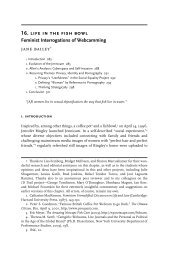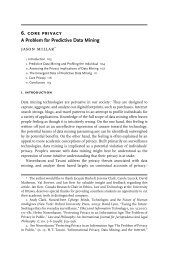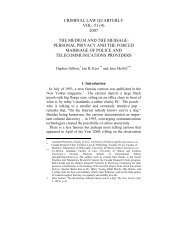Complete Cases Chart - Supreme Court of Canada - On the Identity ...
Complete Cases Chart - Supreme Court of Canada - On the Identity ...
Complete Cases Chart - Supreme Court of Canada - On the Identity ...
Create successful ePaper yourself
Turn your PDF publications into a flip-book with our unique Google optimized e-Paper software.
Case Name (<strong>Court</strong>)<br />
(Judge)<br />
Location/Method <strong>of</strong> Search Relevant Statutes Issues/Holdings<br />
- (1) whe<strong>the</strong>r <strong>the</strong> search violates s. 8 <strong>of</strong> <strong>the</strong>C<strong>Chart</strong>er? - Y/N<br />
- (2) whe<strong>the</strong>r to exclude evidence by s. 24(2)? – Y/N<br />
Reasoning<br />
- (1) relevant to s.8 + CASES (Kokesch, Plant, Hunter, Tessling, Edwards)<br />
- (2) relevant to 24(2) + CASES (Collins)<br />
Charron, J.A.; Abella<br />
and Austin JJ.A. (con).<br />
* final level – SCC<br />
refused leave to<br />
appeal<br />
Surveillance<br />
R. v. Laurin<br />
[1997] 98 O.A.C. 50<br />
Morden A.C.J.O.;<br />
McKinlay and Laskin<br />
JJ.A. (con).<br />
* no history<br />
Surveillance – Visual<br />
R. v. Noseworthy<br />
[1997] 100 O.A.C. 76<br />
Austin J.A.;<br />
McMurtry and<br />
McKinley JJ.A. (con).<br />
* final level<br />
Property – Home<br />
(Warrant)<br />
- Police received a phone call<br />
tip regarding marijuana<br />
cultivation.<br />
- Police surveiled <strong>the</strong> house<br />
from outside locations close<br />
to <strong>the</strong> appellant’s basement<br />
apartment, and observed<br />
visual and olfactory evidence<br />
<strong>of</strong> cannabis cultivation,<br />
which led to a conviction for<br />
cultivation and possession.<br />
-The appellant seeks to<br />
determine whe<strong>the</strong>r <strong>the</strong> police<br />
observations were a<br />
warrantless search.<br />
- A search warrant for <strong>the</strong><br />
accused’s home was issued<br />
under s.487, <strong>the</strong> judicial<br />
power to issue an anticipatory<br />
search warrant.<br />
-Many items were seized.<br />
- Narcotics Control Act, ss.<br />
6(1) and 3(1);<br />
- <strong>Chart</strong>er, ss.8 and 24(2).<br />
- Criminal Code, s. 487.01.<br />
- <strong>Chart</strong>er, ss.8 and 24(2).<br />
- (1) Did <strong>the</strong> search and seizure violate s.8?<br />
• YES<br />
- (2) Should <strong>the</strong> evidence be excluded?<br />
• NO<br />
- (1) Did <strong>the</strong> search and seizure violate s.8?<br />
• NO<br />
- (1) With regard to <strong>the</strong> appellant’s side yard, <strong>the</strong> appellant had no right to exclude,<br />
but <strong>of</strong>ficers had no right to be <strong>the</strong>re.<br />
- The appellant’s reasonable expectation <strong>of</strong> privacy was infringed by police because<br />
<strong>the</strong>y had no right to be on <strong>the</strong> property and make observations through <strong>the</strong> window<br />
from 2 inches away.<br />
- There is no reasonable expectation <strong>of</strong> privacy regarding smells emanating from<br />
one’s apartment into <strong>the</strong> hallway.<br />
- The court referred to an American case which found a diminished expectation <strong>of</strong><br />
privacy <strong>of</strong> residents <strong>of</strong> multiple occupancy dwellings (La Fave, U.S.).<br />
- (2) There are three broad categories for exclusion (Collins).<br />
- The justice system is brought less into disrepute by admitting <strong>the</strong> evidence than<br />
excluding it.<br />
- Ref. to Hunter v. Southam (objective <strong>of</strong> s.8).<br />
- Ref. to Plant (cultivation <strong>of</strong> marijuana is a serious <strong>of</strong>fence).<br />
- Ref. to Edwards (totality <strong>of</strong> circumstances).<br />
- Ref. to Kokesch (where a warrant is obtained through a <strong>Chart</strong>er violation, <strong>the</strong><br />
evidence can be excluded under s.24(2).<br />
- Under s.487.01(4), where a reasonable expectation <strong>of</strong> privacy exists, a judge<br />
issuing a warrant is to impose terms and conditions to ensure respect <strong>of</strong> privacy “as<br />
much as possible”.<br />
-The <strong>Court</strong> determined that <strong>the</strong> trial judge’s narrow interpretation <strong>of</strong> <strong>the</strong><br />
authorization <strong>of</strong> anticipatory search warrants in s.487.01 is inconsistent with <strong>the</strong><br />
purpose and legislative scheme <strong>of</strong> <strong>the</strong> provision: “Parliament intended in s. 487.01 to<br />
create a flexible power that would be available in a broad range <strong>of</strong> investigative<br />
circumstances provided that:<br />
(a) <strong>the</strong> Hunter v. Southam reasonableness criteria are met;<br />
(b) granting an order is in <strong>the</strong> best interests <strong>of</strong> <strong>the</strong> administration <strong>of</strong> justice;<br />
(c) interference with bodily integrity is not permitted; and<br />
(d) no o<strong>the</strong>r provision can be used to authorize <strong>the</strong> order.”<br />
67







